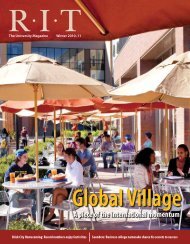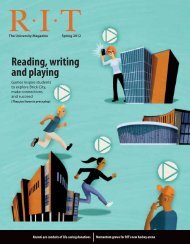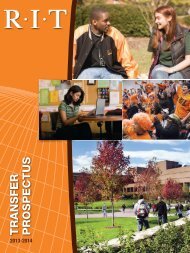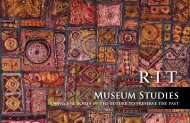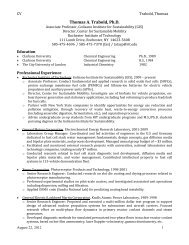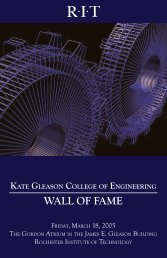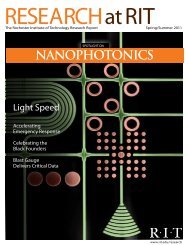Fall / Winter 2012 - Rochester Institute of Technology
Fall / Winter 2012 - Rochester Institute of Technology
Fall / Winter 2012 - Rochester Institute of Technology
Create successful ePaper yourself
Turn your PDF publications into a flip-book with our unique Google optimized e-Paper software.
Focus Area | Human-Centered Computing<br />
Human-Centered Computing<br />
by William Dube<br />
VIDEO LINK<br />
A key problem in biomedical imaging is the difficulty <strong>of</strong> combining<br />
human expertise with the power <strong>of</strong> advanced computing. Researchers<br />
at RIT are attacking this problem by utilizing visual perception techniques,<br />
computer modeling, and computational linguistics to infuse<br />
human expertise into content-based image retrieval systems.<br />
Creating Human-Centered Image Retrieval<br />
Several years ago Anne Haake, pr<strong>of</strong>essor in RIT’s Golisano<br />
College <strong>of</strong> Computing and Information Sciences, undertook<br />
a sabbatical at the National Library <strong>of</strong> Medicine that included<br />
user research in Content-Based Image Retrieval (CBIR).<br />
The computer-based technique, which catalogs and retrieves<br />
images from a database <strong>of</strong> defined characteristics, is considered<br />
a potential technical improvement over current image<br />
databases used in medical diagnosis and prognosis.<br />
“The images taken from an individual patient could be<br />
compared to previous images taken by that medical center or<br />
other centers around the world,” says Haake, who was trained<br />
in biology and s<strong>of</strong>tware development and now studies humancomputer<br />
interaction and biomedical informatics. “Thousands<br />
<strong>of</strong> images could be handled and analyzed quickly and previous<br />
data about how tumors progress or how a particular disease may<br />
look at different stages could be easily transmitted to doctors.”<br />
However, in reviewing different CBIR systems as part <strong>of</strong> her<br />
NLM research, Haake noted that the technology was hindered<br />
because it did not effectively take into account human analysis<br />
<strong>of</strong> the images themselves or the expertise <strong>of</strong> the analyst during<br />
the early design stages.<br />
Analyzing Biomedical Images:<br />
The team is working with a<br />
group <strong>of</strong> derma tologists to<br />
develop a Human-Centered<br />
CBIR system for dermatology<br />
databases that has the<br />
potential to greatly enhance<br />
diagnosis and prognosis <strong>of</strong><br />
diseases from skin<br />
conditions to cancer.<br />
“CBIR assumes a certain level <strong>of</strong> uniformity in the viewer, that<br />
every person looking at the image sees it the same way, uses the<br />
same terminology to describe what they see, and has the same<br />
level <strong>of</strong> expertise,” she adds. “However, this does not take into<br />
account expert knowledge and past experience, which are crucial<br />
in image semantics, making content retrieval and comparison<br />
problematic at best and impossible in some cases.”<br />
Haake has sought to address this issue by developing specific<br />
models <strong>of</strong> human expertise and tacit knowledge that can<br />
increase the overall “intelligence” <strong>of</strong> CBIR systems.<br />
Through a multidisciplinary research team with imaging<br />
scientist Jeff Pelz, computer scientist Pengcheng Shi, dermatologist<br />
Cara Calvelli, and computational linguist Cecilia Ovesdotter<br />
Master-Apprentice Interaction<br />
During Image Inspection<br />
Data Analysis<br />
Outcome <strong>of</strong> Human-Defined<br />
Perceptually Relevant<br />
Image Decriptions<br />
Monitor eye<br />
movements<br />
Fixation counts, durations<br />
Region(s) <strong>of</strong> Interest<br />
Expert<br />
Novice<br />
Capture<br />
verbal<br />
descriptions<br />
Images<br />
on ET Monitor<br />
Transcription, NLP,<br />
UMLS Mapping<br />
+<br />
+<br />
Hierarchy <strong>of</strong> concepts,<br />
terms related to ROI<br />
Hybrid Classifiers<br />
Research at RIT<br />
3



